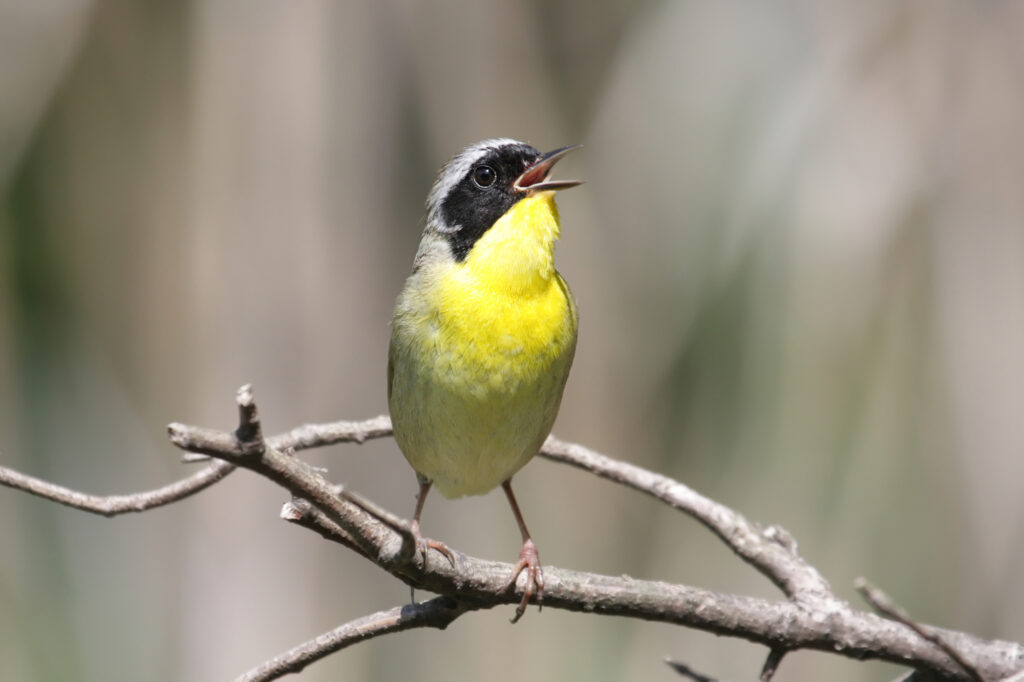Whether you’re hungry for thriving nightlife or the best peaches you’ve ever had, Georgia seems to have it all. It’s also home to 20 small bird species of many shapes and sizes!
Georgia’s diverse landscape of swamps, plains, and forests makes it a haven for small bird species. Songbirds are often fond of dense, forested areas where they can easily forage for food or hide from predators.
If you’ll be swinging by the state – or live in Georgia and want to do some birdwatching – keep reading. This list will showcase 20 small birds in Georgia by their frequency, behavior, and feeding patterns.
Tufted Titmouse
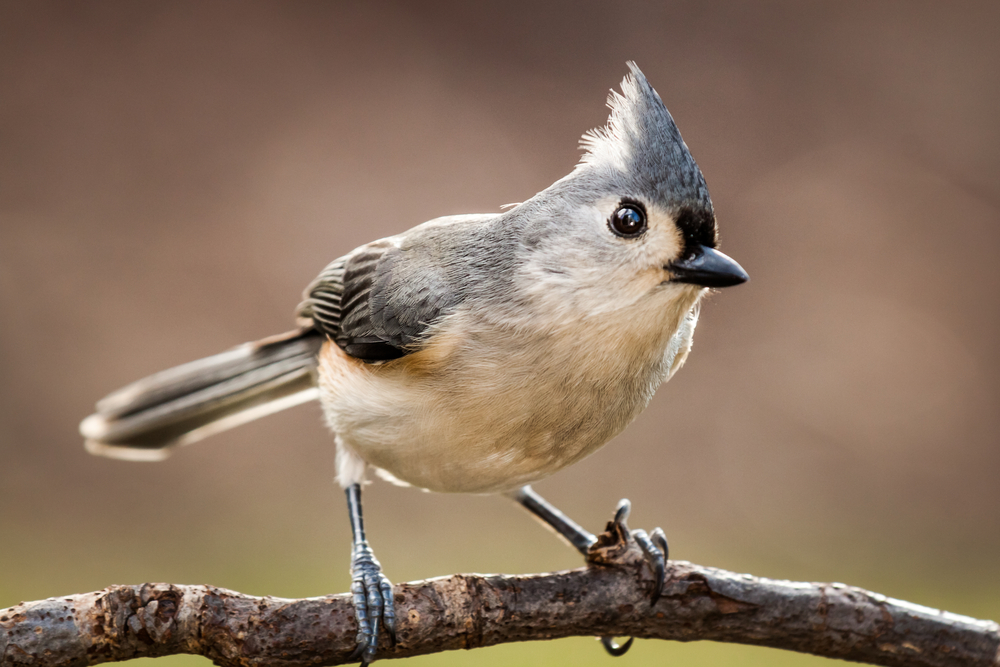
- Species Name: Baeolophus bicolor
- Length: 14 cm to 16 cm
- Weight: 17 grams to 26 grams
- Wingspan: 20 cm to 26 cm
This charming little songbird appears year-round in Georgia. They’re one of the easiest small bird species to find in the state if you’re a fan of forested areas.
The tufted titmouse is a striking little bird, boasting a light gray body with a white belly and black striped face. These songbirds have a little cinnamon brown along their sides and a characteristic tufted head.
Males and females look very similar, though males are a little larger. These birds are usually solitary except for breeding season, where they’ll forage in small groups.
Tufted titmice are most commonly found in forested areas, though they’ll visit well-tended parks and backyards. They enjoy a diverse diet of insects, berries, seeds, and nuts – you can attract them to your backyard bird feeder with sunflower seeds or suet.
Northern Parula

- Species Name: Setophaga americana
- Length: 10 cm to 12 cm
- Weight: 5 grams to 11 grams
- Wingspan: 16 cm to 18 cm
The northern parula usually shows up in Georgia during breeding season. Their tiny size and foraging habits can make them tricky to spot, but their coloration is very distinctive.
The male northern parula is a dashing bird with a blue-gray body, white stomach, and narrow beak. His most distinctive features are his yellow throat, yellow chest, and white markings around his eyes.
Female northern parulas look similar but lean toward a dusky olive green instead of blue-gray.
Northern parulas enjoy forested areas but are also found in swamps and bogs. They’re known to sometimes hang upside down from trees while foraging for insects or berries.
They have a distinctive buzzing trill that sounds like tweeeee-zip, tweeeee-zip. There are often long pauses in between.
Orchard Oriole
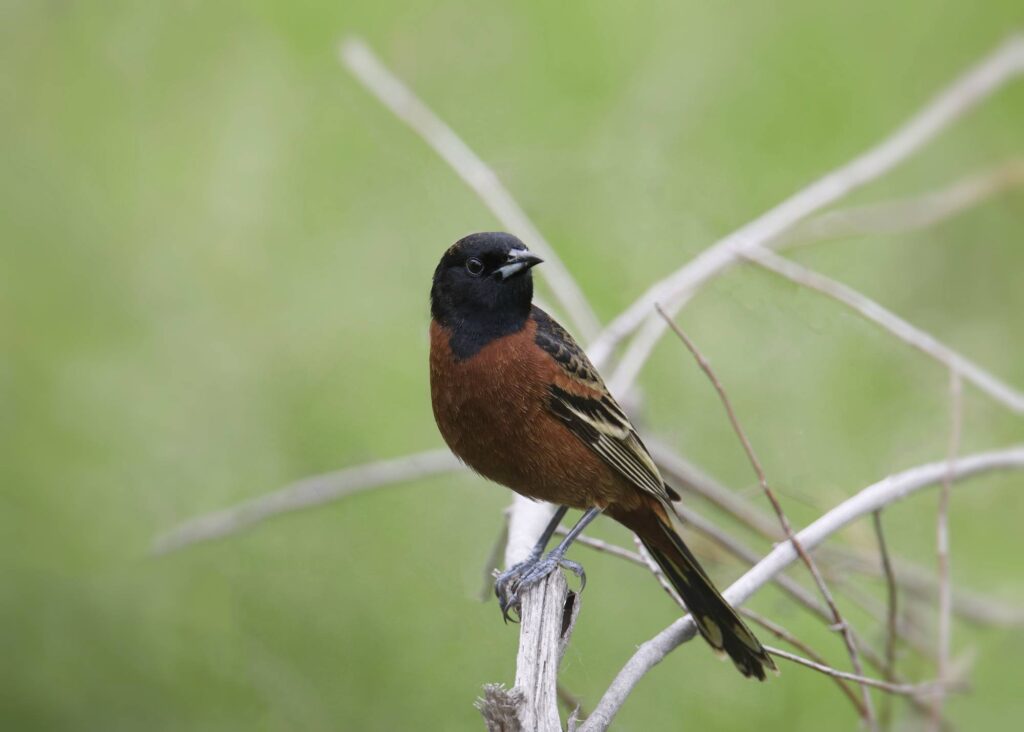
- Species Name: Icterus spurius
- Length: 15 cm to 18 cm
- Weight: 16 grams to 28 grams
- Wingspan: 25 cm
These striking birds are a fleeting sight in Georgia, usually only showing up during breeding season before migrating.
The male orchard oriole has a black head, black wings, and a vivid chestnut-brown stomach. Females look quite different with a yellow-green body and gray wings with white bands.
Orchard orioles don’t visit dense forests or flat areas, preferring lightly forested locations such as farms, orchards, and parks. Their diet changes depending on the season – they prefer insects in the summer, then switch to fruit and seeds during the winter.
Orchard orioles are well-known for their elaborate courtship displays where they sing, bow, or bring food to a prospective mate.
American Goldfinch

- Species Name: Spinus tristis
- Length: 11 cm to 14 cm
- Weight: 19 cm to 22 cm
- Wingspan: 11 grams to 20 grams
These iconic songbirds show up in the northern portion of the state year-round, but during non-breeding season in the south.
The American goldfinch is a welcome sight for its bright plumage and charming song. Male American goldfinches have a lemon-yellow body, black wings, and white wingspots.
They have a distinctive black cap and orange bill you can spot at a distance. However, their plumage becomes more muted outside of breeding season – in fact, they look almost like females.
American Goldfinches generally prefer wide, open spaces with plenty of shrubs for foraging. Expect to see them in backyards, fields, meadows, and occasionally by roadsides.
Try attracting these birds to your backyard with nyjer seeds, especially with a sock feeder where large birds will be less likely to push them away.
House Finch
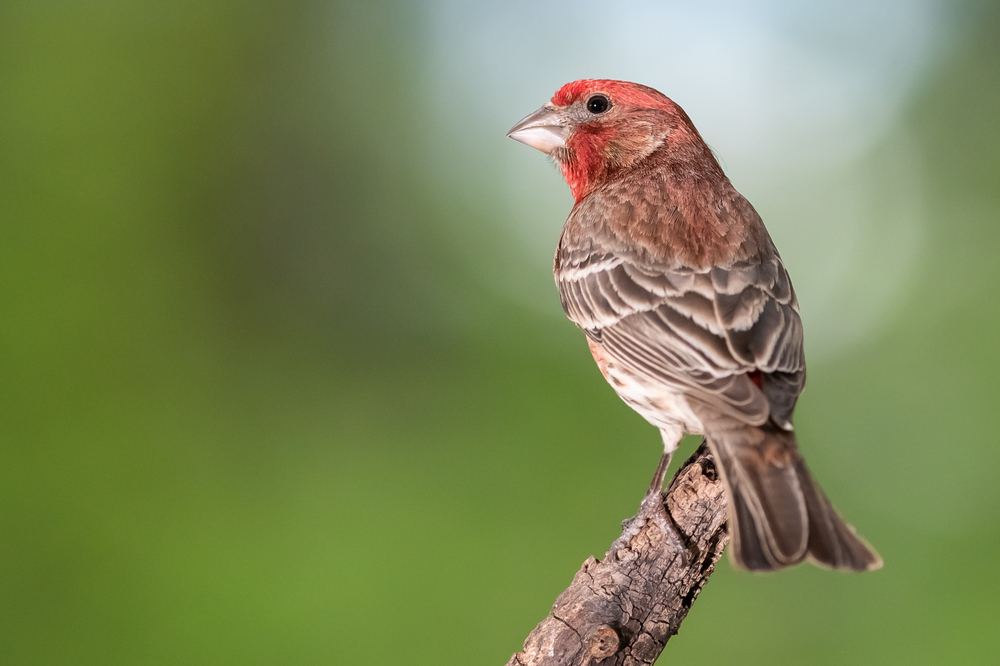
- Species Name: Haemorhous mexicanus
- Length: 12 cm to 15 cm
- Weight: 21 grams
- Wingspan: 20 cm to 25 cm
These widespread birds are commonly found throughout Georgia all year long, though they’re a little rarer in the southernmost part of the state.
The house finch is widespread around the United States and incredibly easy to spot, making them a prime addition for beginning birders. Males have a round, gray-brown body and a distinctive red blush on their chest.
Female house finches seem sparrow-like at a glance with their muted gray-brown bodies and streaked feathers. Both birds have the characteristic conical beak finches are known for.
These social, chatty birds often eat seeds, berries, and fruits, found in both forested and urban environments. You can easily attract them to your feeder with sunflower seeds, but be mindful – they’re territorial and may scare away other birds.
House finches and American goldfinches are just a few finch species you’ll find in Georgia, so check out this list if you want to see more.
Carolina Wren

- Species Name: Thryothorus ludovicianus
- Length: 12 cm to 14 cm
- Weight: 18 grams to 23 grams
- Wingspan: 29 cm
The Carolina wren is seen throughout Georgia all year long. Their unique foraging habits make them a fun challenge for beginning birdwatchers.
The Carolina wren has a sleek and narrow body, boasting a needle-like beak and a flag-like tail that sticks straight up. They’re cinnamon brown with a white belly and a white ‘eyebrow’.
Males and females look very similar to each other, though males are a little larger. Males are also the only ones who sing, letting loose a distinctive chee-ee-werr chee-ee-werr pattern.
These little birds prefer dense and overgrown areas such as thick gardens, shrubbery, forest floors, and swamps. With so many leaves and twigs, they can easily root around for caterpillars and beetles.
You can attract Carolina wrens to your backyard with piles of leaves or by stocking your backyard feeder with mealworms. Check out our list of wrens in Georgia to see more common (and rare!) species.
Indigo Bunting

- Species Name: Passerina cyanea
- Length: 11 cm to 13 cm
- Weight: 14 grams
- Wingspan: 18 cm to 23 cm
You’re most likely to glimpse indigo buntings during breeding season in Georgia.
The male indigo bunting is a striking bird with jewel-like coloration, boasting bright blue plumage with an iridescent shimmer. Their beaks are a pale gray and their eyes are covered with a thick black stripe.
Female indigo buntings are the complete opposite of their males with a dusty brown body and dark brown wings. If you look closely, they sometimes have a little blue along their wings and tail.
These birds enjoy more ambiguous environments, lingering on forest edges and open woodland. They eat a broad diet of insects, berries, flower buds, and seeds.
You’re most likely to find indigo buntings foraging in flocks, though you can attract them to your feeder with blackberries or elderberries.
Pine Warbler
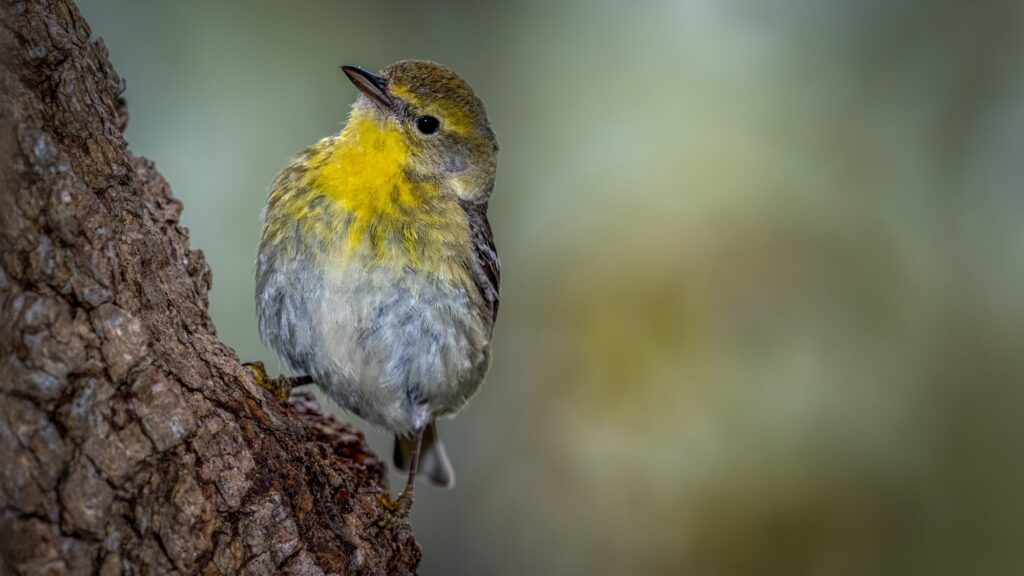
- Species Name: Setophaga pinus
- Length: 13 cm to 14 cm
- Weight: 12 grams
- Wingspan: 19 cm to 23 cm
You can find the pine warbler year-round in Georgia.
The male pine warbler is a charming fellow with a vivid yellow body, gray wings, and two white wing bars. Their squat, round body, and short beak make them look like they’re always pouting
Female pine warblers are more dusky, covered in a light yellow-gray with brown wings.
Pine warblers enjoy a broad diet of seeds, berries, and insects. They frequently forage on the ground, though they sometimes cling to pine cones and root around for food.
If you prefer backyard birding, try attracting these pine warblers with sunflower chips or suet.
Chipping Sparrow

- Species Name: Spizella passerina
- Length: 12 cm to 15 cm
- Weight: 11 grams to 17 grams
- Wingspan: 21 cm
The chipping sparrow shows up throughout most of Georgia during breeding season, though will linger in the southern portion of the state in non-breeding season.
You don’t have to be a birder to be familiar with chipping sparrows. These widespread birds have a light gray body, streaked brown wings, and a distinctive cinnamon-brown cap.
Their black eye band and squat body are easy to spot at a glance. Males and females look similar to each other, while juveniles are usually missing the brown cap.
Chipping sparrows usually eat seeds, but will sometimes eat insects during breeding season. They’re comfortable in many environments and will crop up in people’s backyards, dense gardens, spacious parks, shrubby fields, and open clearings.
Chipping sparrows enjoy both platform and ground feeders, so stock up on nyjer seeds if you want to enjoy a little backyard birding.
Song Sparrow

- Species Name: Melospiza melodia
- Length: 11 cm to 18 cm
- Weight: 22 grams
- Wingspan: 18 cm to 25 cm
Song sparrows are a year-round resident in northern Georgia but expand to the rest of the state during winter.
It’s time to put your attention to detail to the test! The male song sparrow is distinctive from the chipping sparrow with its white stomach, speckled body, and striped head.
Males and females look similar, though the males will be slightly larger.
These shy birds prefer to keep to themselves, often foraging in meadows and fields for insects or seeds. They’re less likely to visit more urban areas compared to other sparrows.
Try attracting these birds to your backyard feeder with some millet – just make sure the area is quiet or they’ll be startled away.
House Sparrow
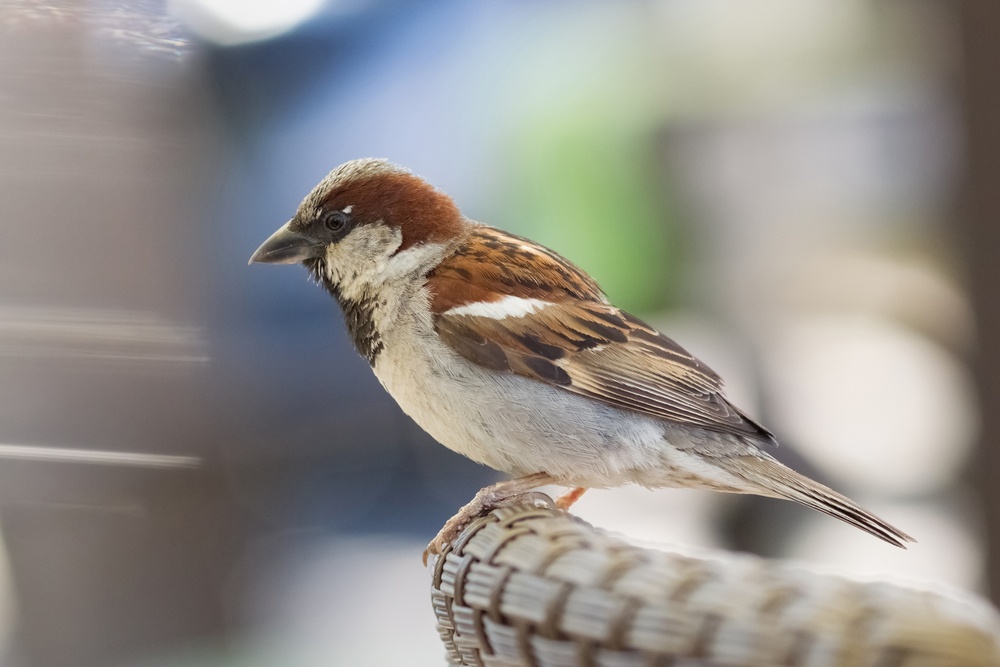
- Species Name: Passer domesticus
- Length: 14 cm to 18 cm
- Weight: 24 grams to 39 grams
- Wingspan: 19 cm to 25 cm
This extremely common bird is a year-round resident in Georgia and is found in a variety of environments.
Male house sparrows are distinctive with their chocolate brown body and brown cap, boasting a white belly and notable black throat. They also have black eye bands and a rounded bill.
Female house sparrows are more subtle with their light gray-brown bodies, having no black throat or black eye bands. They do, however, have a light tan-yellow eyebrow and streaked wings.
These widespread birds are comfortable just about anywhere, seen in forests, parks, gardens, backyards, and even downtown areas. They eat a variety of seeds, weeds, and insects, even scavenging in garbage cans when the opportunity presents itself.
You can easily attract these birds to your backyard with oats, berries, and any commercial bird seed you get your hands on.
European Starling

- Species Name: Sturnus vulgaris
- Length: 19 cm to 23 cm
- Weight: 58 grams to 101 grams
- Wingspan: 31 cm to 44 cm
These distinctive birds are easily found in Georgia all year round.
It’s impossible to confuse a European starling for any other bird. Males and females both boast a dark body that shifts to blues and greens beneath the light.
Their features are also covered in twinkling white spots, giving them an almost starry appearance. While males and females look similar, males have a blue spot on their beak while females have a pink spot.
Although this bird is sometimes seen as a pest species due to their tendency to eat crops, some birders appreciate it for also eating crop-damaging insects.
These birds are easy to spot in agricultural fields and meadows as they forage for insects and fruit.
Brown-Headed Nuthatch

- Species Name: Sitta pusilla
- Length: 9 cm to 11 cm
- Weight: 10 grams to 12 grams
- Wingspan: 16 cm to 18 cm
This delightful little bird is common throughout most of Georgia, though is a little rarer up north.
Brown-headed nuthatches are adorable birds with round bodies and a mixture of dusky brown and blue feathers. They have a dark, needle-like beak and a fluffy, white belly.
Males and females look very similar, even confusing experienced birders.
These social birds are quite fun to watch with their elaborate grooming patterns and love of bird feeders. You can easily attract them with sunflower seeds or suet during the winter.
Common Yellowthroat

- Species Name: Geothlypis trichas
- Length: 11 cm to 13 cm
- Weight: 8.5 grams
- Wingspan: 15 cm to 19 cm
The common yellowthroat is generally found in Georgia year-round.
This little warbler is a must-see for experienced and beginner birders alike. Males have a dusky olive body, a bright yellow throat, and a very thick black mask.
Female common yellowthroats are much more subtle, boasting a light olive body, tan-yellow belly, and pink legs.
The common yellowthroat has a dynamic and twittering song composed of chirps, warbles, and buzzing trills. You’re most likely to spot them (or hear them) in marshland or shrubby fields – just don’t expect to see them frequenting any heavily populated areas.
They live on a pretty strict diet of insects and have a fondness for spiders. However, they occasionally switch to fruit and seeds when they’re low on options – try attracting them with mealworms in a shrubby area of your backyard.
Ruby-Throated Hummingbird

- Species Name: Archilochus colubris
- Length: 7 cm to 9 cm
- Weight: 2 grams to 6 grams
- Wingspan: 8 cm to 11 cm
These lovely birds usually show up in Georgia during breeding season, and then promptly migrate.
The male ruby-throated hummingbird is a flashy fellow, boasting a dusky green body with a white belly and distinctive red throat. Females are no slouch, having a rich green body, white stomach, and white tips on their tails.
Ruby-throated hummingbirds will switch between nectar and tiny insect species, though they occasionally eat tree sap. They’re much more active during the day and are a common sight in gardens, orchards, and backyards.
You can easily attract these birds with a classic hummingbird feeder. Here’s a tip – use a feeder that’s orange or red, as this resembles some of their favorite flowers.
Eastern Bluebird

- Species Name: Sialia sialis
- Length: 16 cm to 21 cm
- Weight: 27 grams to 34 grams
- Wingspan: 25 cm to 32 cm
You’ll easily spot this bold bird throughout Georgia year-round.
The Eastern bluebird is a welcome sight for many birders due to its brilliant plumage and melodious song. Males have bold blue wings, a blue head, and a cinnamon-brown stomach.
Females look similar, though with more blue-gray coloration and a stomach that mixes brown and white. They can also lean toward a brighter orange color.
These highly social birds can travel in flocks of a hundred or more, often frequenting forests or quiet neighborhoods. They’re fans of insects – particularly grasshoppers and earthworms – but they’ll occasionally eat berries.
Small, covered feeders are best to attract bluebirds to reduce the chances of larger birds scaring them off. Mealworms and suet are some of the best foods to attract them.
Yellow-Rumped Warbler

- Species Name: Setophaga coronata
- Length: 12 cm to 15 cm
- Weight: 12 grams
- Wingspan: 19 cm to 24 cm
You’ll usually see the yellow-rumped warbler during non-breeding season in Georgia, though they’ll migrate far north for breeding season.
The yellow-rumped warbler is one of the most striking additions to a birder’s list. Males have a dark gray body covered in bold white streaks, though their most notable trait is their yellow throat and yellow rump.
Females look similar but lean toward a lighter gray with softer white streaks.
These birds prefer open spaces such as agricultural fields, shrubby fields, and along forest edges. They like to switch up between berries and insects, though they often forage for spiders.
If you want to invite these striking birds to your backyard, stock up on suet in the winter or sunflower seeds during the warmer months.
Carolina Chickadee

- Species Name: Poecile carolinensis
- Length: 11 cm to 13 cm
- Weight: 9 grams to 12 grams
- Wingspan: 15 cm to 20 cm
These cute little birds are a year-round resident in Georgia, so you won’t have to wait long to spot one.
I’ve always loved chickadees for their charming appearance and bouncy behavior. The Carolina chickadee has a light gray-blue body and white belly – they’re best known for their black cap and black throat.
Males and females look extremely similar, so don’t feel bad if you get them confused.
These birds eat a mixture of fruits and insects, swift enough to catch insects mid-flight. They prefer forested areas, though they may visit neighborhoods with a high amount of trees and shrubs.
Attract these birds to your backyard with hopper feeders stocked with sunflower seeds. Sometimes Carolina chickadees hang out with other birds – such as tufted titmice – so you may enjoy quite the show!
Downy Woodpecker

- Species Name: Dryobates pubescens
- Length: 14 cm to 18 cm
- Weight: 20 grams to 33 grams
- Wingspan: 25 cm to 31 cm
You’ll easily find downy woodpeckers throughout Georgia.
The male downy woodpecker is a showstopper of a bird, boasting streaked black and white wings with a bright white stomach. He has a notable red spot on the side of his head.
Female downy woodpeckers look very similar to the males but with no red spot.
Downy woodpeckers are most commonly seen in densely forested areas where they’ll be busily drumming trees for food or places to roost. They usually eat insects but occasionally switch to berries and seeds.
While they’re best known for their drumming sound, they sometimes let out a little pik-pik call.
Eastern Phoebe

- Species Name: Sayornis phoebe
- Length: 14 cm to 17 cm
- Weight: 16 grams to 21 grams
- Wingspan: 26 cm to 28 cm
You can find Eastern phoebes in most of Georgia year-round, but they only show up in the southern portion of the state during breeding season.
This round little bird has soft, subtle coloration. Their bodies are hazy gray with a white belly and short, black beak.
Males and females look pretty similar, though males will be a little taller and have darker wings.
These birds enjoy wide, open spaces with plenty of room to forage for insects. Expect to find them in fields, meadows, and occasionally along the edges of forests.
It’s rare to see these birds visit backyard feeders, but you can invite them over by having plenty of tall grass for insects to hide in.
Georgia Is Heaven for Fans of Small Bird Species
You couldn’t have picked a better state to search for warblers, wrens, and finches. Georgia has the rich, diverse nature needed to keep birds and outdoorsy birders happy for a long time.
If you want a few spots to spot some of these species, check out the Harris Neck National Wildlife Refuge and the Piedmont National Wildlife Refuge.
If you want to learn about other bird species in Georgia, check out our other lists:

